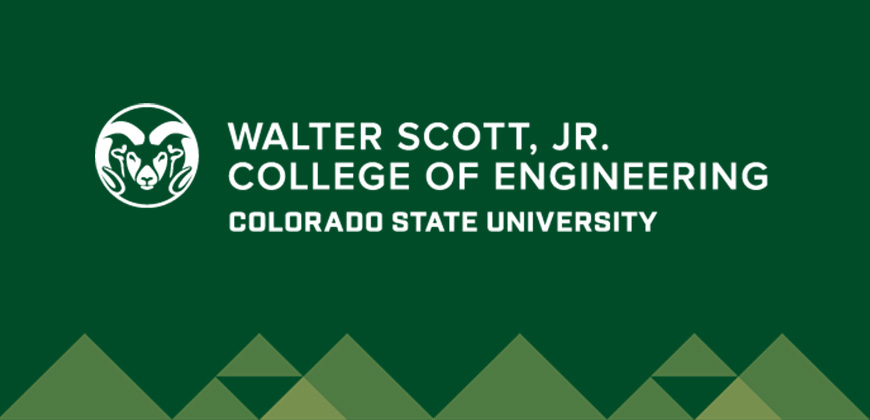
Engineering was not a top-of-mind educational target when the State Agricultural College of Colorado welcomed its first students in 1879.
Agriculture – in all of its many facets – was the primary focus. The “mechanical arts” simply were not viewed as essential.
Still, in 1882 the entity we now know as CSU’s College of Engineering sprung to life with the creation of a single class. Over the years, the College of Engineering has been responsible for graduating more than 20,000 students and creating life-changing innovations.
Elwood Mead, whose expertise in irrigation engineering helped build the Hoover Dam (and the reservoir it created – Lake Mead) was the first notable faculty member. Ralph Parshall revolutionized irrigation by creating the Parshall flume. And Maury Albertson used his international engineering connections to create the Peace Corps.
In 1953, a kid from Omaha, Neb., would graduate with a degree in civil engineering and begin a long successful career. Sixty-three years later, Walter Scott, Jr. would donate $53.3 million, forever changing the trajectory of the college.
CSU’s programs in mechanical, civil, computer, electrical, environmental, biomedical, chemical, and biological engineering, along with the atmospheric science department, are highly regarded across the country and around the world.
Not bad for a discipline that did not exist at the tiny land-grant college when it first opened.
Historical highlights
1870 – State Agricultural College of Colorado is created as part of the Morrill Act.
1879 – The first classes are held at the college. There were five students.
1882 – President Charles Ingersoll helps establish the Department of Mechanics and Drawing – the precursor to the College of Engineering – at Colorado Agricultural College.
1883 – Elwood Mead, for whom Lake Mead is named, joins the CAC faculty, focusing on irrigation engineering.
1889 – Arthur L. Davis, son of a Colorado farmer, receives the college’s first degree.
1907 – Electrical engineering is permanently installed as a major, with future college president Charles A. Lory serving as head of the department. Lory, for whom the Lory Student Center is named, went on to serve 31 years as president.
1922 – Faculty member Ralph Parshall revolutionizes irrigation when he receives a patent for the Parshall flume – a device still in use today.
1934 – Edward House, an alumnus and longtime faculty member, is named the first dean of engineering.
1935 – CAC is renamed Colorado State College of Agriculture and Mechanic Arts.
1938 – Nephi Christensen becomes dean, emphasizing hydraulics and irrigation programs; during World War II Christensen left for the Ballistic Research Laboratory in Maryland, where he made significant contributions to the development of rocketry.
1944 – CSC is renamed Colorado Agricultural and Mechanical College.
1947 – Maury Albertson, who would later help establish the Peace Corps, joins the faculty.
1949 – William E. Morgan, for whom the Morgan Library is named, becomes president of Colorado A&M and inspires two decades of unprecedented growth at the college.
1950 – Alumnus Jack Cermak, working with Albertson, constructs CSU’s first wind tunnel, pioneering research in fluid mechanics and wind engineering.
1955 – Engineering student A.R. Chamberlain, who would go on to serve as president, earns Colorado A&M’s first Ph.D. in engineering.
1957 – Colorado A&M becomes Colorado State University.
1962 – The Department of Atmospheric Science, led by Herbert Riehl, is established. Among those on Riehl’s team is William Gray, who would become a world-renowned expert on hurricane forecasting.
1963 – The Engineering Research Center (ERC) is dedicated on the Foothills campus; it includes the new hydraulics lab and the fluid dynamics and diffusion lab.
1964 – The Colorado Water Resource Research Institute is established at CSU.
1966 – Lionel Baldwin is named dean.
1972 – CSU establishes the Solar Energy Applications Laboratory (SEAL). This leads to the construction of the Solar Village on the Foothills campus.
1974 – All five doctoral programs in the college are accredited for the first time.
1975 – The Agricultural Engineering Research Center (AERC) is established.
1977 – CSU launches a program in chemical engineering.
1980 – The Colorado Institute for Research in the Atmosphere (CIRA) is established at CSU.
1981 – The George T. Abell Chair for COE becomes CSU’s first fully endowed faculty chair.
1982 – CSU establishes the Center for Computer Assisted Engineering, reflecting a growing interest in computer engineering.
1992 – The Engines and Energy Conversion Lab (EECL) is established in the abandoned Fort Collins power plant, reflecting a growing interest in clean energy.
2003 – National Science Foundation-funded Engineering Research Center for Extreme Ultraviolet (EUV) Science and Technology is established.
2006 – The Center for Multiscale Modeling of Atmospheric Processes, a National Science Foundation Science and Technology Center focused on improving the representation of cloud processes in climate models, is established.
2006 – CloudSat, a NASA Earth Science System Pathfinder Satellite, is launched. CSU professor Graeme Stephens is the principal investigator.
2013 – The state-of-the-art Suzanne and Walter Scott, Jr. Bioengineering Building opens on campus.
2014 – The Powerhouse Energy Campus, an LEED Platinum building, is established.
2015 – The Center for Risk-Based Community Resilience Planning, a National Institute of Standards and Technology-funded Center of Excellence, is established.
2016 – The Walter Scott, Jr. College of Engineering makes its debut, thanks to a $53.3 million gift from alumnus Walter Scott, Jr. The gift is the largest in CSU’s history.